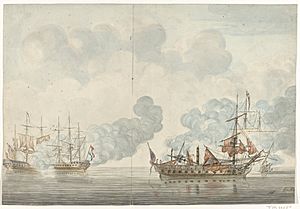Action of 30 May 1781 facts for kids
Quick facts for kids Action of 30 May 1781 |
|||||||
|---|---|---|---|---|---|---|---|
| Part of the Fourth Anglo-Dutch War | |||||||
 The Battle of Cape St Mary, Joseph Marianus |
|||||||
|
|||||||
| Belligerents | |||||||
| Commanders and leaders | |||||||
| Strength | |||||||
| 2 frigates | 2 frigates | ||||||
| Casualties and losses | |||||||
| 27 killed 65 wounded 1 frigate damaged |
42 killed 84 wounded 240 captured 1 frigate damaged 1 frigate captured |
||||||
The Action of 30 May 1781 was a naval battle fought between two British warships and two Dutch warships. It happened off the Barbary Coast near the Cape of St. Mary. In the Netherlands, this event is known as the "sea battle of Cape St Mary."
During the fight, which lasted over two hours, Captain William Peere Williams-Freeman of the British ship Flora (with 36 guns) forced Captain Pieter Melvill's Dutch ship Castor (also 36 guns) to surrender. Soon after, Captain Gerardus Oorthuys of the Dutch ship Den Briel (36 guns) made Captain Thomas Pakenham surrender his British ship Crescent (28 guns). However, the Flora quickly came to Crescent's aid. This forced Oorthuys to retreat before he could take over the Crescent.
Contents
Why Did the Battle Happen?
During the Fourth Anglo-Dutch War, a group of merchant ships from the Dutch East Indies was leaving the Mediterranean Sea. Two Dutch warships, the 36-gun frigates Castor and Den Briel, were escorting them. A frigate is a type of fast warship.
The British noticed these ships near Gibraltar. So, two British frigates, the 36-gun Flora and the 28-gun Crescent, went after them. The Dutch ships reached the Atlantic Ocean and fired their guns, which scared off the British for a moment.
Captain Carnbee, leading the Dutch ships, decided not to chase the faster British ships. His main job was to protect the merchant ships. So, the Dutch ships turned south under the cover of darkness, hoping to reach the Canary Islands safely.
How the Battle Unfolded
On the morning of May 30, 1781, the Dutch sailors saw the British ships still following them. The British ships started firing their cannons. The Dutch captains, Carnbee and Oorthuys, tried to get one of the British ships caught between their two vessels, but they failed.
The battle then turned into a one-on-one fight. The Den Briel fought the Crescent, and the Castor fought the Flora.
The Fight Between Castor and Flora
The Castor was an older ship, 23 years old, with smaller cannons. Its cannons could fire a total of 372 pounds of cannonballs at once. The newer Flora was much stronger, able to fire 720 pounds of cannonballs in a single shot.
The Castor quickly became very damaged. Its sails and ropes were destroyed, and it had holes below the waterline, causing five feet of water to flood its bottom. Most of its cannons were out of action. Out of its 230-person crew, 30 were killed and 40 were wounded. Captain Carnbee then raised a white flag, which meant surrender. He and his crew were taken onto the Flora. The damaged Castor was then taken in tow by the British as a prize ship (a captured ship).
The Fight Between Den Briel and Crescent
The battle between the Den Briel and the Crescent was very different. The Den Briel's cannons knocked down the main mast and mizzen mast (the back mast) of the Crescent. The Den Briel had 12 sailors killed and 44 wounded. The Crescent suffered much more, with 27 killed and 65 wounded, including its captain, who was slightly hurt.
Both ships were badly damaged. About an hour after the Crescent surrendered, the mast of the Den Briel also fell overboard. The Dutch ship also had no small boats left that could float. This meant they couldn't send a crew to take over the Crescent as a prize. The Crescent then managed to be towed away by the Flora. Captain Oorthuys had to watch his captured ship escape.
What Happened After the Battle?
Using temporary sails, Captain Oorthuys managed to reach the port of Cadiz in Spain on June 2. The merchant ships he was protecting also reached Spain safely, without being attacked by the British.
Meanwhile, the British Captain Pakenham was towing the two badly damaged ships. He later met two French warships in the English Channel and was defeated. The Flora managed to escape, but the Crescent was recaptured by the French.
Pakenham refused to take command of the Crescent again. He believed that because he had surrendered to the Den Briel, his command was canceled. So, the Castor became a French prize. It was too damaged to be used and was soon taken apart in a French shipyard. Captain Carnbee and the other Dutch prisoners were sent back home.
The battle became big news in the Netherlands. Captains Carnbee and Oorthuys were praised and compared to famous Dutch naval heroes like Michiel de Ruyter and Maarten Tromp. In Britain, Captain Pakenham was put on trial by a military court for surrendering his ship. However, he was found innocent. It was proven that he only surrendered when his ship's masts had fallen and its cannons could no longer fire, making further fighting impossible.
Images for kids



